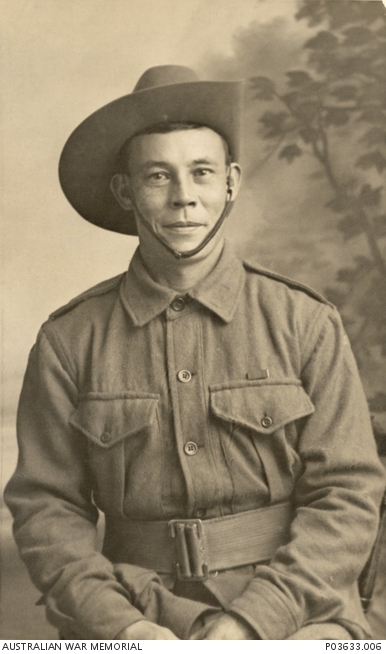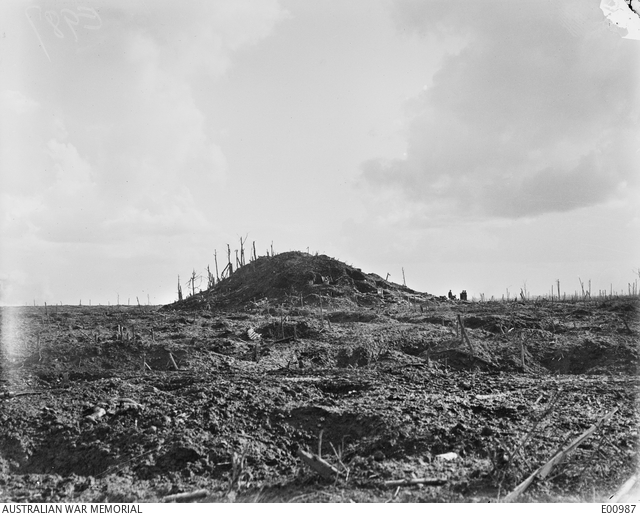William Sing
Portrait of Private William Edward Sing DCM, England, c 1918. Gale’s Studios Ltd
William “Billy” Sing was born in Clermont, Queensland, in 1886 to an English mother and Chinese father. He and his two sisters were brought up in a rural environment, helping their parents with their market garden from a young age. The milk, fruit, and vegetables they produced were delivered around town. He was involved in competitive shooting with the local rifle club, and gained experience in working with horses during his time as a station hand.
In 1910, Billy moved to Proserpine where he worked as a cane cutter. When the First World War broke out four years later, he decided to enlist with the Australian Imperial Force (AIF). It was not always easy for men with Chinese heritage to enlist, as anti-Chinese sentiment grew with the introduction of the Immigration Restriction Act 1901. This policy became known as the White Australia Policy.
Billy was accepted into the AIF in October 1914. He was 28 years old, and listed his occupation as a horse driver. He was assigned to the 5th Light Horse Regiment, and sent to Egypt in December for further training.
After the disastrous landing on Gallipoli on 25 April 1915 it was decided that reinforcements would be needed, and that the light horse regiments could be sent to help. As the terrain on Gallipoli was deemed unsuitable for the horses, the animals were left behind in Egypt and the men of the 5th Light Horse Regiment served as infantry. Although Billy could not make use of his horse-riding skills, his accuracy with a rifle would ensure his name became known across the peninsula.
Turkish snipers were causing havoc, finding plenty of places to hide in the rugged hills and shooting at opposing forces. The Allies decided they needed snipers of their own, and Billy was one of the men selected for this role. Billy would sit still for hours at a time with an observer, in scorching summer sun or freezing cold conditions as winter set in. They used periscopes to help locate the Turkish snipers, while protecting themselves from enemy fire. Billy was slightly wounded in August, but did not require hospitalisation. He was later evacuated due to illness, suffering from ailments including Influenza, rheumatism, and myalgia (muscle ache).
Billy was given various nicknames due to his accuracy as a sniper, including “the assassin”, and “crack shot of the Anzacs”. For his work on Gallipoli, he was Mentioned in Despatches by General Sir Ian Hamilton, and awarded the Distinguished Conduct Medal (DCM). The recommendation for the DCM stated:
During this period (July to September 1915) this man has inflicted 119 casualties on the Turks by sniping. These casualties have been verified by the officers, NCOs, and men in the Regiment who have been observing for him with telescopes. These casualties are apart from those he inflicted when he had no observers …
Billy’s fame spread beyond the soldiers at Gallipoli and his growing tally was written about in the Australian, British and American press.
A medallion presented to Billy Sing for his work on Gallipoli. A sniper has been engraved in the middle.
Australian soldiers were evacuated from Gallipoli in December 1915 after an exhausting eight-month campaign in which approximately 44,000 allied troops and 85,000 Turkish soldiers were killed.
After returning to Egypt, Billy was again admitted to hospital, this time with the mumps. He was transferred to the 31st Battalion, but due to ongoing illness did not join his unit on the Western Front until the end of July 1916. This may have proved lucky for Billy, as the 31st Battalion had experienced a dreadful introduction to fighting in France: over half of its men were killed or wounded during the Battle of Fromelles just weeks before he joined.
As the type of warfare conducted on the Western Front was different from that that occurred on Gallipoli, Billy underwent further training. In March 1917, he suffered a gunshot wound to the leg, and was sent to England to recover. Around this time, Billy travelled to Edinburgh where he met 21-year-old Scottish waitress, Elizabeth Stewart. They married in June, but did not have much time together, as Billy returned to his unit in August.
The intensity of the fighting continued, as the 31st Battalion made its way to Polygon Wood in Belgium. The men were once again exposed to heavy artillery bombardments. They were also affected by mustard gas as they attempted to advance across German lines. In acknowledgement of Billy’s bravery, he was recommended for a Military Medal. His citation records:
At Polygon Wood on 26/28th September, 1917, after the capture of the final objective and notwithstanding a terrific bombardment by the enemy, this soldier volunteered to take out a fighting patrol to mop up some snipers who were causing casualties. By his dash and success in dealing with these our front line was secured and consolidation continued. During the whole operation his skill in picking out and dealing with snipers was uncanny.
Although Billy was not awarded the Military Medal, he was again Mentioned in Despatches. His bravery was later recognised with the awarding of a Belgian military decoration, the Croix de Guerre.
Billy was in and out of hospital for the remainder of the war, battling the effects of mustard gas and recurring problems with his leg wound. He received another gunshot wound in February 1918, this time to his back. He returned home in July on the troopship Boonah, and was medically discharged soon after. Although Billy’s wife was approved for passage in December, the Victorian Passenger Lists 1839-1923 notes that she did not arrive in Australia until 1923. It is unclear whether the couple reunited in Australia.
Billy returned to a hero’s welcome at Proserpine, and was given a sum of money from the Patriotic League. He took up a Soldier Settlement block at Clermont in May 1919, which he named “Pernois” after a small village in France. His attempt at sheep farming was unsuccessful, however, and he walked off the land, like many other returned servicemen. Billy had limited success with goldmining, but the work was tough, adding to the strain on his already weakened body. He moved to Brisbane, and died of heart failure in 1943, as the world was in the grip of another world war. He was found alone in a boarding house, with very little money, and no sign of his medals or awards.
Billy was buried without fanfare at Lutwyche Cemetery in Brisbane. In 1994, money was raised to create a new headstone paying tribute to his service. The headstone reads:
His incredible accuracy contributed greatly to the preservation of the lives of those with whom he served during a war always remembered for countless acts of valour and tragic carnage.
In 1995, a statue of Billy was erected in Clermont, showing him in action as a sniper on Gallipoli. An Australian Army sniper team also chose to remember Billy during their 2004 service in Iraq, by naming their post the “Billy Sing bar and grill”. More recent memorialisations of Billy include a shooting competition in his name, and the Billy Sing Memorial which was unveiled in Brisbane in 2015.



